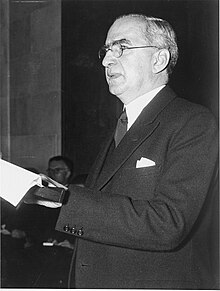George S. Messersmith | |
|---|---|
 | |
| United States Ambassador to Argentina | |
| In office April 12, 1946 – June 12, 1947 | |
| President | Harry S. Truman |
| Preceded by | Spruille Braden |
| Succeeded by | James Cabell Bruce |
| United States Ambassador to Mexico | |
| In office February 24, 1942 – May 15, 1946 | |
| President | Franklin D. Roosevelt Harry S. Truman |
| Preceded by | Josephus Daniels |
| Succeeded by | Walter C. Thurston |
| United States Ambassador to Cuba | |
| In office March 8, 1940 – February 8, 1942 | |
| President | Franklin D. Roosevelt |
| Preceded by | J. Butler Wright |
| Succeeded by | Spruille Braden |
| United States Assistant Secretary of State | |
| In office July 9, 1937 – February 15, 1940[1] | |
| President | Franklin D. Roosevelt |
| Preceded by | Sumner Welles |
| Succeeded by | Hugh R. Wilson |
| United States Ambassador to Austria | |
| In office April 7, 1934 – July 11, 1937 | |
| President | Franklin D. Roosevelt |
| Preceded by | George Howard Earle III |
| Succeeded by | Grenville T. Emmet |
| Personal details | |
| Born | George Strausser Messersmith October 3, 1883 Fleetwood, Pennsylvania, U.S. |
| Died | January 29, 1960 (aged 76) |
| Profession | Lawyer, Diplomat |
George Strausser Messersmith (October 3, 1883 – January 29, 1960) was a United States ambassador to Austria, Cuba, Mexico, and Argentina. Messersmith also served as head of the consulate in Germany from 1930 to 1934, during the rise of the Nazi Party.[2]
He was best known in his day for his controversial decision to issue a visa to Albert Einstein to travel to the United States.[3] He is also known today for his diplomatic handling of Edward VIII and Wallis Simpson, later Duke and Duchess of Windsor, in the era before World War II.[4]
- ^ Plischke, Elmer (January 1, 1999). U.S. Department of State: A Reference History. Greenwood Publishing Group. p. 275. ISBN 978-0-313-29126-5. Retrieved March 3, 2014.
- ^ Stiller, Jesse H. (1987). George S. Messersmith, Diplomat of Democracy. University of North Carolina Press. ISBN 978-0-8078-1721-6.
- ^ Schaap, Jeremy (2007). Triumph: The Untold Story of Jesse Owens and Hitler's Olympics. Houghton Mifflin Harcourt. pp. 71, 242. ISBN 978-0-618-68822-7. Retrieved March 3, 2014.
- ^ Higham, Charles (1988). The Dutchess of Windsor: The Secret Life. McGraw Hill.